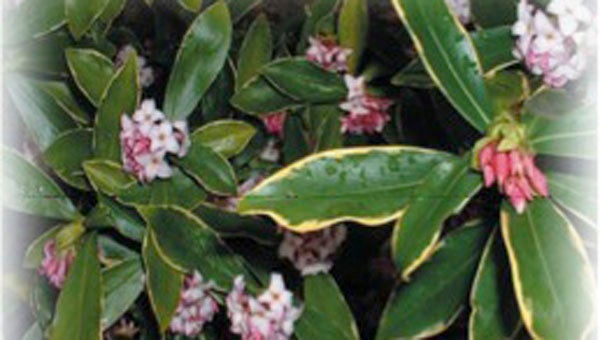DISHING THE DIRT with the Extension Master Gardeners: Daphne … the fragrance will grab your attention
Published 7:47 pm Thursday, March 5, 2015
Gardens are sites of experimentation and optimism providing priceless opportunities to engage all the senses. Fragrance in the garden provides an extra dimension of beauty and imbues a sense of serenity. Fragrant plants command our attention and admiration. If you couple divine winter fragrance with interesting foliage, the resulting effect is decidedly positive….such is the case with the Daphne shrub.
With over 50 types, Daphnes are simply incredible garden jewels. The Daphne does put up with conditions not entirely to their liking. They like well drained, moisture retentive un-amended soil is an imperative. Choose your site carefully to ensure morning sun only. An early spring application with a Rose formulation fertilizer is helpful. In clay soil, improve drainage with perlite or gravel and sand. Pinching the plant back after bloom will insure a more compact habit and encourage heavier blooming. There are very few old Daphne plants in America’s gardens because they can and will die overnight if unhappy.
Daphne odora, (Winter Daphne), is a heavily branched, mounding shrub growing to 4’ x 4’ high and wide. It flowers in February and March and has impressive persistent blooms.
Daphne cneorum (Rock Daphne) is low growing, spreading to about 3’ wide and a 1’ high. It is often grown in containers, elevated beds or as border statements. Draping over a rock wall, it is breathtaking. Arguably, the most flashy with heavenly fragrance, infertile, rocky soil serve it best.
Daphne xtransatlantica caucasica, (Jim’s Pride) is the most floriferous and the least temperamental. Semi evergreen and reaching 4’ wide by 5’ high, it blooms January to May depending on site.
Daphne retusa blooms in May. It is a diminutive, globular, evergreen shrub that is lovely throughout the year.
Daphne burkwoodii (Carol Mackie) is most popular and easiest to grow. Variegated, semi-evergreen with small star shaped leaves; Carol blooms in early spring and has a marvelous fragrance. The shrub can grow to 6’ high and 5’ wide. The branches are almost succulent. Protection from snow and ice is advisable.
Daphne genkwa blooms on nude branches in early spring. Growing to about 3’ high and wide, the plant has little or no fragrance, but the soft bluish bloom is captivating.
Quick Facts:
Blooming period: Late winter, early springtime
Size: Small to dwarf, mounding shrub
Exposure: Morning sun only, protect from Midday and afternoon sunlight and heat
Keys to Success: Prune after bloom to maintain compact shape, size and stimulate lush bloom; application of dolomite lime when planting to diminish acidity of soil Sulfate of magnesium is very desirable. Daphnes prefer rocky, more alkaline soil and require good drainage. The root system is extensive and needs room to reach, so plant the Daphne in a very large hole. Mulch lightly to maintain moisture.
The information for this article is given courtesy of the Extension Master Gardeners who are volunteers under direction of the Beaufort County Cooperative Extension. They are available to answer your questions concerning lawns, vegetables, trees, ornamentals, fruits, plant problems and diseases, pests, soil and many other horticulture issues relating to gardening in North Carolina. Reach a Master Gardener through the Hot Line at 252-946-0111 where you can leave a voice message or email the Master Gardeners your question at beaufortcomg@gmail.com and a volunteer will respond to you inquiries.
Kay Graham is a certified Master Gardener volunteer.
Gardening Calendar March
Lawn Care
• Cool season lawns can be fertilized like 10-10-10. Avoid slow-releasing fertilizers. Do not fertilize summer warm season grasses.
• Crabgrass herbicides can be applied when the forsythia blooms.
• Fescue and bluegrass can be seeded now if not done in the fall.
Fertilizing
• Fertilize shrubs.
• Shade trees can be fertilized.
• Emerging spring flowering bulbs can be fertilized.
• Asparagus beds can be fertilized in early March before spear growth begins.
• Ponds should be fertilized starting this month and should be continued for the next 7 months.
Planting
• Trees and shrubs can be transplanted. Fruit trees and grapevines can be planted until the buds begin to break.
• Perennial like: columbine, hollyhock, coreopsis, daisy, and phlox.
• Rose bushes can be planted this month.
• Broccoli, cabbage, and cauliflower can be set out in the garden around mid-March.
• Beets, Carrots, Chinese cabbage, kale, kohlrabi, lettuce, Swiss chard, turnips, and potatoes can be planted anytime this month.
• Start annual flowers and warm-season vegetables inside.
Propagation
• Perennials like daylily and Shasta daisy can be divided at this time if the ground is dry enough.
Pruning
• Prune fruit trees.
• Wait for spring flowers to fade before pruning them. Pansies for example will flower longer if older flowers are removed.
• Roses can be pruned later this month.
• Overgrown shrubs can be severely pruned if needed, except for needled evergreens.
Spraying
• Landscape shrubs can be sprayed to control the following pest: euonymus-scale, juniper-spruce spider mites, and hybrid rhododendron-borers.
• Spray all fruit trees with dormant oil to eliminate some insects. This is especially important if the tree has just been pruned.
• Spray apple and pear trees with streptomycin while they are blooming to control fireblight.
Other Activities
• Check gardening equipment to make sure it is in good working order.
• Consider buying gardening supplies like fertilizer, insecticides, and fungicides while there are still adequate amounts.
• Consider ordering new varieties along with tried-and-true varieties to see how they compare. Experimenting with varieties is fun and has virtually no ill effects.






